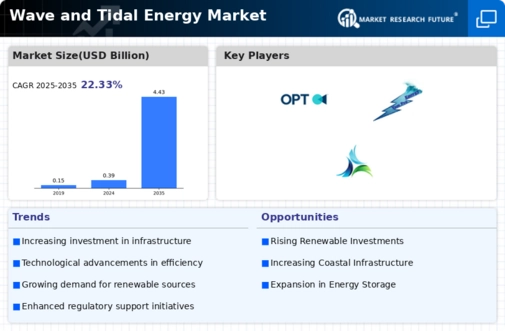Rising Energy Demand
The Wave and Tidal Energy Market is experiencing a surge in energy demand, driven by population growth and industrial expansion. As urbanization accelerates, the need for sustainable energy sources becomes increasingly critical. According to recent estimates, global energy consumption is projected to rise by approximately 30% by 2040. This growing demand for energy, coupled with the finite nature of fossil fuels, propels the exploration of renewable energy sources, including wave and tidal energy. The industry is poised to benefit from this trend, as governments and private sectors seek to diversify their energy portfolios. The integration of wave and tidal energy into the energy mix could potentially provide a reliable and consistent power supply, addressing both current and future energy needs.
Growing Public Awareness
The Wave and Tidal Energy Market is benefiting from a growing public awareness of renewable energy and its benefits. As communities become more informed about the environmental impacts of traditional energy sources, there is a rising demand for cleaner alternatives. Public support for renewable energy initiatives is crucial for the successful implementation of wave and tidal energy projects. Surveys indicate that a significant portion of the population favors investments in renewable energy, viewing it as a pathway to energy independence and environmental stewardship. This heightened awareness can lead to increased pressure on policymakers to prioritize renewable energy solutions, thereby creating a favorable environment for the wave and tidal energy industry. As public sentiment continues to shift, the industry may find new opportunities for growth and collaboration.
Technological Innovations
The Wave and Tidal Energy Market is witnessing rapid technological innovations that enhance the efficiency and viability of energy generation. Advances in turbine design, energy conversion systems, and materials science are contributing to improved performance and reduced costs. For instance, the development of more resilient materials for tidal turbines can extend their operational lifespan and reduce maintenance costs. Additionally, innovations in energy storage solutions are enabling better integration of wave and tidal energy into existing power grids. As technology continues to evolve, the industry is likely to see a decrease in the levelized cost of energy, making wave and tidal energy more competitive with traditional energy sources. This technological progress could attract further investment and accelerate the deployment of wave and tidal energy projects.
Government Incentives and Policies
The Wave and Tidal Energy Market is significantly shaped by government incentives and supportive policies aimed at promoting renewable energy. Many governments are implementing feed-in tariffs, tax credits, and grants to encourage investment in wave and tidal energy projects. These financial incentives can lower the barriers to entry for new market participants and stimulate innovation within the industry. For example, countries like the United Kingdom and Canada have established dedicated funds to support the development of marine energy technologies. Such initiatives not only foster growth in the wave and tidal energy sector but also contribute to job creation and economic development. As policies continue to evolve, the industry may experience increased stability and predictability, further attracting investment.
Environmental Sustainability Initiatives
The Wave and Tidal Energy Market is significantly influenced by the increasing emphasis on environmental sustainability. As climate change concerns escalate, there is a pressing need to transition from fossil fuels to renewable energy sources. Wave and tidal energy, being inherently low in carbon emissions, aligns with global sustainability goals. Many countries are setting ambitious targets to reduce greenhouse gas emissions, with some aiming for net-zero emissions by 2050. This shift towards cleaner energy sources is likely to drive investments in wave and tidal energy technologies. Furthermore, the industry may see enhanced support from environmental organizations advocating for the adoption of renewable energy solutions, thereby fostering a more sustainable energy landscape.


















Leave a Comment